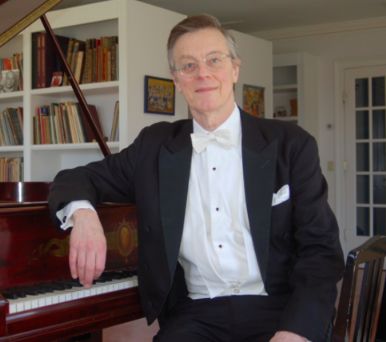|
Recital
ELEGANT VOCAL MASTERY AT ROSES SIGNATURE RECITAL
by Pamela Hicks Gailey
Sunday, February 25, 2024
Recital
DEMANDING SCHUMANN WORK IN MUSIC AT OAKMONT RECITAL
by Terry McNeill
Thursday, November 9, 2023
Recital
RARE RAVEL IN MENDO FESTIVAL'S PRESTON HALL
by Terry McNeill
Thursday, July 20, 2023
Recital
FRENCH FLAVOR IN RARE FOUR-HAND RECITAL
by Judy Walker
Sunday, January 15, 2023
Recital
ASSERTIVE PIANISM IN YAKUSHEV'S OCCIDENTAL RECITAL
by Terry McNeill
Sunday, November 13, 2022
Recital
HEROIC LIM PERFORMANCE AT STEINWAY SOCIETY RECITAL
by Abby Wasserman
Sunday, September 18, 2022
Recital
AGGRESSIVE PIANISM IN MYER'S MENDO FESTIVAL RECITAL
by Terry McNeill
Thursday, July 14, 2022
Recital
UNIQUE ELEGANCE IN GALBRAITH GUITAR RECITAL
by Gary Digman
Friday, April 29, 2022
Recital
ALLURING GLASS WORKS IN WEILL RECITAL
by Terry McNeill
Friday, March 25, 2022
Recital
FORGOTTEN BACH SHINES IN YARDEN'S OAKMONT RECITAL
by Terry McNeill
Thursday, March 10, 2022
|
 |
 Pianist Peter Serkin |
SERKIN'S SINGULAR MOZART AND BACH PLAYING IN WEILL RECITAL
by Terry McNeill
Friday, November 9, 2018
Returning to Weill Hall following a fire-related recital cancellation in 2017, pianist Peter Serkin programmed just three works in his Nov. 7 concert, three masterworks that challenged both artist and audience alike.
It needs to be said at the outset that Mr. Serkin takes a decidedly non-standard approach to Mozart’s B Minor Adagio (K. 540) and the K. 570 B-Flat Major Sonata, and to Bach’s Goldberg Variations that comprised the second half. Current international Mozartians (Andras Schiff, Mitsuko Uchida) play with little damper pedal and brisk tempos, similar to more distant Mozart virtuosi Alfred Brendel, Paul Badura-Skoda, Lili Kraus, Emil Gilels and Walter Gieseking.
Mr. Serkin began by playing the lovely Adagio with a chaste tone and at a pace that at 15 minutes was many minutes slower than prevailing practice. He used large ritards and occasionally the musical line slowed almost to a vanishing point. His unique hand vibrato on key tops (his father Rudolf also did this) elicited comments from some of the 350 in the audience. And, no, the sound doesn’t change by key message, as once the wool piano hammer hits the string, the sound only decays.
Slow playing over 21 minutes in the Sonata highlighted the contrapuntal lines of the work, one of Mozart’s last big piano pieces. The pianist’s self effacing approach and intense focus worked best in the long and complex adagio where his attention to the smallest compositional detail was palpable. Small breaks in the sound (“luftpause” in German) bordered on affectation. The fermata on the penultimate chord must have lasted eight seconds.
In the allegretto finale Mr. Serkin surprised by finding a few inner voices but notes in scale playing were never distinct because of generous pedal application, and with such a pokey tempo (for an allegretto) the interpretation became a little mundane. Perhaps listeners in Weill might have thought Mr. Serkin’s approach to Mozart was limited by pianistic technique, but I think the result is simply how he feels the music, and the light he sheds on the composer’s genius. Certainly there was much to admire in such an interpretative concept, although with ponderous tempos there was danger that the musical line would be breached. It never was.
Bach’s towering Goldberg Variations (a sarabande with 30 variations) followed intermission, and began with a not slow setting out of the chaste theme, albeit with the pianist teasing the ends of phrases. In the nearly 50-minute traversal of the 1742 work Mr. Serkin again eschewed contemporary interpretations, choosing instead slow tempos with room for contrapuntal voicing and sporadic left-hand accents. He wrapped his arms around the Goldberg using warm pianistic colors, constant legato phrasing, softly arpeggiated chords that ended many individual variations, and accentuation of Bach’s piquant dissonances.
A shortcoming in this artistic conception was the potential for boredom, as the slow tempos and instrumental volume throughout the variations were similar, and in fact there wasn’t a strong forte all evening. In sum, Mr. Serkin’s self effacing approach to Bach was always interesting and authoritative, but for me ultimately unconvincing.
Silence in the hall lasted many seconds after the final soft unison g notes, the artist slowly lifting his hands and humbly acknowledging the standing ovation. No encore was offered or needed.
Classical Sonoma reviews rarely mention extra-musical items, such as artist clothing or interminable commentary from the stage, but the tall pianist was uniquely attired in a conventional vested business suit, pocket handkerchief and dark red tie, and sat almost motionless at his instrument.
|

